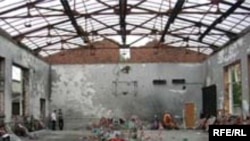Parts of the report, penned by a member of the parliamentary commission investigating the siege, were published just days ahead of its second anniversary.
The most stunning allegation made pertains to responsibility for the two blasts that precipitated the bloody end of the siege of School No. 1, which resulted in the deaths of more than 330 people, half of them children.
More than 1,000 hostages were taken at the Beslan school in the early hours of September 1, 2004, by guerrillas demanding an end to the war in nearby Chechnya. A standoff ensued until September 3, when Russian personnel stormed the school after explosions were heard and a blaze broke out in the gymnasium that held most of the hostages.
Familiar Investigator, Different Result
The official line has long been that militants set off the initial explosion and that grenades fired by Russian troops could not have started the blaze. The Federation Council's official investigative commission, headed by deputy speaker Aleksandr Torshin, is expected to release its final report in September.
But the independent investigation of explosives expert Yury Savelyev, a member of Motherland (Rodina), veers sharply from the official explanation. Excerpts of Savelyev's 700-page report were published yesterday in "Novaya gazeta" and on the website "Pravda-Beslana" (pravdabeslana.ru).
"Pravda-Beslana" Editor in Chief Marina Litvinovich explained the main findings in an interview with RFE/RL's Russian Service.
"The main conclusion of Savelyev's report concerns the first explosions in the gymnasium on September 3, which set off of the storming of the school," Litvinovich said. "In his report, Yury Petrovich Savelyev [says he] found out that the first shots against the gymnasium were made from a certain weapon -- the first shot was made from an RPO-A thermobaric flame-thrower, or a similar weapon, and the second shot was made from an RShG-1 rocket-propelled grenade."
Investigation Turns
Savelyev told Russia's Ekho Moskvy radio station that his investigation was initially based on the premise that the first two explosions resulted from the hostage takers' homemade explosives. However, he said the scientific evidence simply did not support that scenario.
He said that in conducting his investigation he found that surviving hostages were talking about explosions in parts of the school other than those referred to by officials.
Savelyev concluded that the authorities decided to storm the school building, but wanted to create the impression they were acting in response to actions taken by the hostage takers. Thus, Savelyev believes, the military may have initiated the bloody conclusion to the siege.
"It is known where the shots were fired from," Litvinovich said. "The first shot was fired from a five-story building at 37 Shkolny Pereulok, the second shot was fired from 41 Shkolny Pereulok. Those buildings are adjacent to the school. Accordingly, it is also known where the shots were fired at. The first shot was fired at the gymnasium's attic above the hostages, and the second shot was fired under a gymnasium window. However, it remains unclear who exactly fired the shots, but this question is less important. The more important question is who ordered it."
Numerous Questions Raised
Savelyev's report also claims that police in Chechnya learned of the attacks three hours ahead of time but failed to alert law-enforcement officials in North Ossetia.
He also raises the possibility that as many as 60-70 attackers were involved in the three-day siege. Officials have claimed that 32 hostage takers were involved, and that all but one were killed on September 3. The lone survivor among the hostage takers was sentenced to prison earlier this year.
Savelyev's report has become a lightning rod, drawing prominent supporters and detractors alike.
Stanislav Kesayev, the first deputy chairman of the North Ossetian parliament who headed the republic's investigation of Beslan, told Ekho Moskvy on August 28 that Savelyev "did a thorough job. He relied on his own knowledge as a weapons specialist and as a mathematician." Kesayev's own commission determined that the causes of the first and second explosions were unclear.
And a member of the Beslan Mothers Committee, Ella Kesayeva, told the radio station that Savelyev's findings are comparable to those of the group's own independent investigation. She said Beslan Mothers is preparing to submit an appeal to the authorities.
Murat Kuboyev, a Beslan-based journalist, lauded Savelyev's for making his findings public.
"The Beslan Mothers Committee and the Voice of Beslan hoped very much that Savelyev would in fact make things clear," Kuboyev said. "We have known for a long time that security services were to blame for killing many of the hostages. It does not matter whether they did it intentionally or unintentionally. But the Prosecutor-General's Office flatly refuses to listen to the testimony of eyewitnesses who saw it."
Political Agenda?
However, others have refuted Savelyev's claims and accused him of playing politics.
Arkady Baskayev, a fellow member of the parliamentary investigative commission, told Ekho Moskvy that Savelyev's conclusions are based on personal opinions that "do not match the actual events at all." He said expert examinations were carried out to determine the causes of the initial explosions, and that the scenario Savelyev's has forwarded was ruled out.
Investigators from the Prosecutor-General's Office and the North Ossetian police maintain that there was no concrete information about an impending attack.
On August 16, the official death toll resulting from the siege was raised to 332, when one of the victims died of complications resulting from her injuries.
